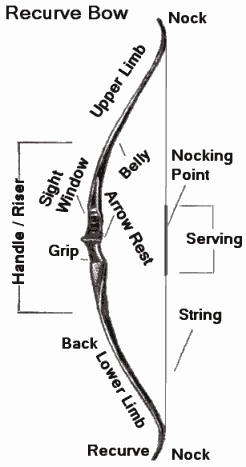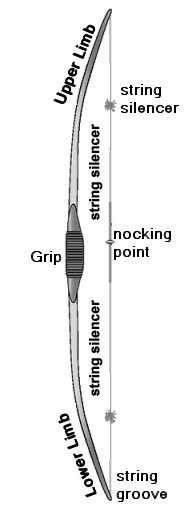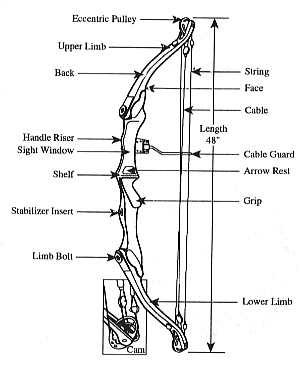Difference between revisions of "Bows and Arrows Basic Reference"
(New page: Archery is usually done using recurve bow, longbow, or compound bow. Of these, the recurve is overwhelmingly the most popular. All bows have largely the same essential components. * Limbs...) |
m |
||
| (14 intermediate revisions by one user not shown) | |||
| Line 1: | Line 1: | ||
Archery is usually done using recurve bow, longbow, or compound bow. Of these, the recurve is overwhelmingly the most popular. All bows have largely the same essential components. | Archery is usually done using recurve bow, longbow, or compound bow. Of these, the recurve is overwhelmingly the most popular. All bows have largely the same essential components. | ||
| − | * Limbs which bend when the string is drawn, and store the energy used to propel the arrow. | + | * Limbs which bend when the string is drawn, and store the energy used to propel the arrow. Bow limbs are generally constructed of man-made materials, such as fiberglass, carbon and syntactic foam. The limbs store the energy of the draw and release it to the arrow. |
* A riser which is the handle part between the limbs. In a one piece bow, the riser and the limbs are, of course, the same piece of material. The riser will usually be made of wood or metal. | * A riser which is the handle part between the limbs. In a one piece bow, the riser and the limbs are, of course, the same piece of material. The riser will usually be made of wood or metal. | ||
| − | * The string | + | * The string is usually made of either "Fast Flight", a hydrocarbon product that also has medical and other uses, or "Kevlar", the material used to make bullet-proof vests. The reinforced bit in the middle is called the serving. Towards the middle of the serving is the nocking point, where the arrow is mounted. |
* An arrow shelf or arrow rest on the riser. This supports the arrow while it is drawn. A shelf is a cutting into the bow riser itself, while a rest is something mounted on the side of the riser. An extended shelf cutout is sometimes referred to as a sight window. Some bows have both shelf and riser; traditional longbows have neither. | * An arrow shelf or arrow rest on the riser. This supports the arrow while it is drawn. A shelf is a cutting into the bow riser itself, while a rest is something mounted on the side of the riser. An extended shelf cutout is sometimes referred to as a sight window. Some bows have both shelf and riser; traditional longbows have neither. | ||
| + | |||
| + | The earliest known archaeological evidence for the bow and arrow comes from Western Europe, where some Mousterian sites are dated to approximately 40,000 years ago. The use of the bow and arrow for hunting and for war dates back to the Paleolithic period in Africa, Asia, and Europe. It was widely used in ancient Egypt, Mesopotamia, Persia, the Americas, and Europe until gunpowder hit the scene. | ||
| + | |||
| + | == Recurve Bow == | ||
| + | |||
| + | {| border=0 | ||
| + | |- | ||
| + | | | ||
| + | [[Image:RecurveBow01.png]] | ||
| + | | | ||
| + | Most recurve bows are five to six feet in length. Some are designed to come apart into pieces for travel and storage, they are referred to as a “takedown” bow. | ||
| + | |||
| + | | ||
| + | |||
| + | To ensure potential energy is stored evenly within the limbs during the draw, the modern recurve bow tips point to the target when unstrung, and parallel to the bowstring when strung. Because the recurve is being pulled opposite the way it naturally curves, there is a lot more tension on the sting and more energy available in a shorter length bow. This innovation allows for a more powerful bow than the longbow that is easier to manage, even allowing for more versatile use such as on horseback. | ||
| + | |||
| + | | ||
| + | |||
| + | The bow handle (riser) will have a cut out on one side where the arrow rests. This is one way to distinguish a modern recurve bow from a longbow. The longbow has no such rest for the arrow. | ||
| + | |} | ||
| + | |||
| + | == Long Bow == | ||
| + | |||
| + | {| | ||
| + | |- | ||
| + | | | ||
| + | [[Image:LongBow01.png]] | ||
| + | | | ||
| + | A longbow has neither the stored energy of the recurve or the ease of accurate aiming as the compound. It is basically the most simplistic bow design. There is no rest for the arrow on the riser. Longbows are basically a stick of one of various types of wood, such as yew, maple, or teak. | ||
| + | |||
| + | | ||
| + | |||
| + | Longbows tend to have narrow limbs and are as tall as the user. Traditional English longbows are also known as “self bows.” This is the oldest bow design and has been used by man for thousands of years. | ||
| + | |||
| + | | ||
| + | |||
| + | The longbow, which was in use in Wales in the 12th cent. became prominent in the Welsh Wars of Edward I in the late 13th cent. For the rest of that century, the English emphasized skill with the longbow; it was inexpensive, mobile, and easily adapted to a peasant army. Only in England did the longbow survive the introduction of gunpowder; it was superseded gradually by firearms. It was a powerful weapon, but it took great strength to pull and years of practice to master. | ||
| + | |||
| + | |} | ||
| + | |||
| + | == Compound Bow == | ||
| + | |||
| + | {| | ||
| + | |- | ||
| + | | | ||
| + | [[Image:CompoundBow01.gif]] | ||
| + | | | ||
| + | The compound bow has a system of cams and pulleys. The draw weight decreases as you pull back so that it is much easier to hold the bow in a fully drawn position. As you release the energy builds up to peek weight supplying all of the available energy. This system offers a significant advantage in holding the bow steady and aiming over a recurve bow. | ||
| + | |||
| + | | ||
| + | |||
| + | Must compound bows also have a special sighting system which includes a peep which serves as the rear sight mounted directly on the bowstring. Telescopic sights are also used on some compound bows. | ||
| + | |||
| + | | ||
| + | |||
| + | It should be noted that it requires a great deal more skill to successfully aim and operate a recurve bow of the same weight as a compound bow. Most competition archery including the Olympics the competitors are not allowed to use compound bows. | ||
| + | |||
| + | |} | ||
| + | |||
| + | == Arrow == | ||
| + | |||
| + | [[Image:Earrow.gif]] | ||
| + | |||
| + | Arrows are typically made of wood, carbon fiber, fiberglass or aluminum. At the point of the arrow is a special tip, the arrow head. The arrow head is a tip and there are different tips available depending on the purpose of the shooter, be it for target practice, hunting, or warfare. On the back end there are feathers or fletchings. On the shaft itself fletchings are glued to stabilize the arrow's flight. On the shaft itself fletchings are glued to stabilize the arrow's flight. | ||
| + | |||
| + | Arrows have to be matched to the draw weight of the bow, and the draw length of the archer. In general it doesn't matter too much if the arrow is a bit too long, but if it's too short you run the risk of it falling off the arrow rest and shooting through your hand. | ||
| + | |||
| + | | ||
| + | |||
| + | | ||
[[Category:Sports and Recreation]] | [[Category:Sports and Recreation]] | ||
| + | [[Category:Archery]] | ||
Latest revision as of 07:26, 30 June 2007
Archery is usually done using recurve bow, longbow, or compound bow. Of these, the recurve is overwhelmingly the most popular. All bows have largely the same essential components.
- Limbs which bend when the string is drawn, and store the energy used to propel the arrow. Bow limbs are generally constructed of man-made materials, such as fiberglass, carbon and syntactic foam. The limbs store the energy of the draw and release it to the arrow.
- A riser which is the handle part between the limbs. In a one piece bow, the riser and the limbs are, of course, the same piece of material. The riser will usually be made of wood or metal.
- The string is usually made of either "Fast Flight", a hydrocarbon product that also has medical and other uses, or "Kevlar", the material used to make bullet-proof vests. The reinforced bit in the middle is called the serving. Towards the middle of the serving is the nocking point, where the arrow is mounted.
- An arrow shelf or arrow rest on the riser. This supports the arrow while it is drawn. A shelf is a cutting into the bow riser itself, while a rest is something mounted on the side of the riser. An extended shelf cutout is sometimes referred to as a sight window. Some bows have both shelf and riser; traditional longbows have neither.
The earliest known archaeological evidence for the bow and arrow comes from Western Europe, where some Mousterian sites are dated to approximately 40,000 years ago. The use of the bow and arrow for hunting and for war dates back to the Paleolithic period in Africa, Asia, and Europe. It was widely used in ancient Egypt, Mesopotamia, Persia, the Americas, and Europe until gunpowder hit the scene.
Contents
Recurve Bow
|
Most recurve bows are five to six feet in length. Some are designed to come apart into pieces for travel and storage, they are referred to as a “takedown” bow.
To ensure potential energy is stored evenly within the limbs during the draw, the modern recurve bow tips point to the target when unstrung, and parallel to the bowstring when strung. Because the recurve is being pulled opposite the way it naturally curves, there is a lot more tension on the sting and more energy available in a shorter length bow. This innovation allows for a more powerful bow than the longbow that is easier to manage, even allowing for more versatile use such as on horseback.
The bow handle (riser) will have a cut out on one side where the arrow rests. This is one way to distinguish a modern recurve bow from a longbow. The longbow has no such rest for the arrow. |
Long Bow
|
A longbow has neither the stored energy of the recurve or the ease of accurate aiming as the compound. It is basically the most simplistic bow design. There is no rest for the arrow on the riser. Longbows are basically a stick of one of various types of wood, such as yew, maple, or teak.
Longbows tend to have narrow limbs and are as tall as the user. Traditional English longbows are also known as “self bows.” This is the oldest bow design and has been used by man for thousands of years.
The longbow, which was in use in Wales in the 12th cent. became prominent in the Welsh Wars of Edward I in the late 13th cent. For the rest of that century, the English emphasized skill with the longbow; it was inexpensive, mobile, and easily adapted to a peasant army. Only in England did the longbow survive the introduction of gunpowder; it was superseded gradually by firearms. It was a powerful weapon, but it took great strength to pull and years of practice to master. |
Compound Bow
|
The compound bow has a system of cams and pulleys. The draw weight decreases as you pull back so that it is much easier to hold the bow in a fully drawn position. As you release the energy builds up to peek weight supplying all of the available energy. This system offers a significant advantage in holding the bow steady and aiming over a recurve bow.
Must compound bows also have a special sighting system which includes a peep which serves as the rear sight mounted directly on the bowstring. Telescopic sights are also used on some compound bows.
It should be noted that it requires a great deal more skill to successfully aim and operate a recurve bow of the same weight as a compound bow. Most competition archery including the Olympics the competitors are not allowed to use compound bows. |
Arrow
Arrows are typically made of wood, carbon fiber, fiberglass or aluminum. At the point of the arrow is a special tip, the arrow head. The arrow head is a tip and there are different tips available depending on the purpose of the shooter, be it for target practice, hunting, or warfare. On the back end there are feathers or fletchings. On the shaft itself fletchings are glued to stabilize the arrow's flight. On the shaft itself fletchings are glued to stabilize the arrow's flight.
Arrows have to be matched to the draw weight of the bow, and the draw length of the archer. In general it doesn't matter too much if the arrow is a bit too long, but if it's too short you run the risk of it falling off the arrow rest and shooting through your hand.



